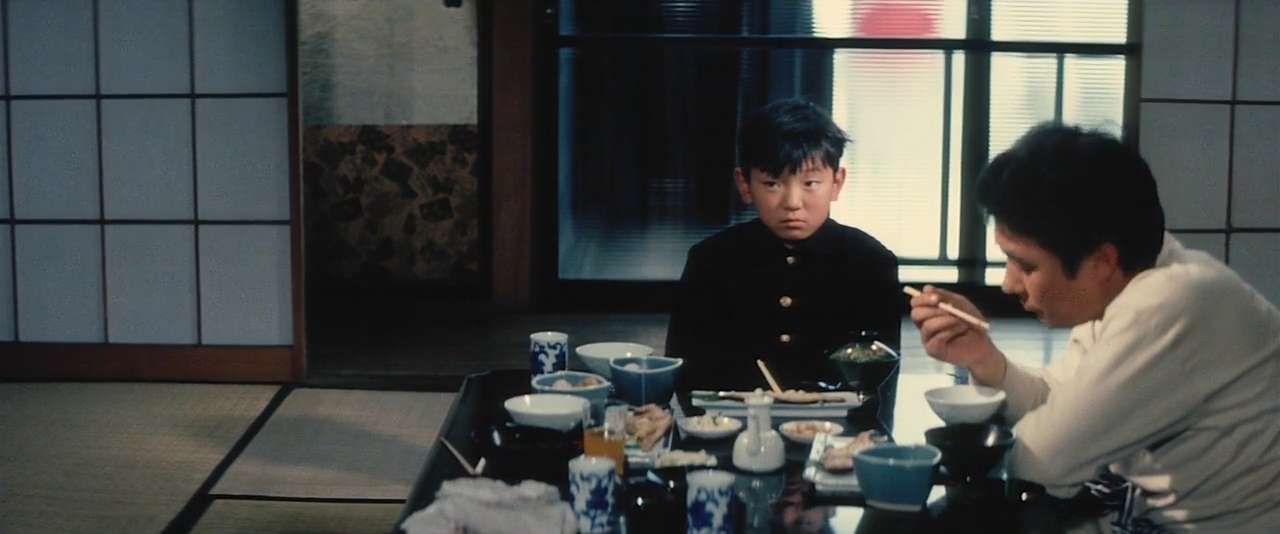– Is there anything I can do for you? – You could make a film about my suffering.کلوزآپ ، نمای نزدیک [Klūzāp, nemā-ye nazdīk / Close-Up] (Abbas Kiarostami, 1990)
Jan
19

Hossain Sabzian on the back of a motorcycle on a busy tree-lined, four lane street. He's holding a large potted rose-red dahlia. DP: Ali Reza Zarrindast.
biography
Les abysses [The Depths] (Nikos Papatakis, 1963)
Dec
2
sister's birthday

Michèle and Marie-Louise (real-life sisters Francine and Colette Bergé) as the real-life Papin sisters in their shared bedroom. DP: Jean-Michel Boussaguet.
Sisters for [OP's] sister's birthday.
Na wylot [Through and Through] (Grzegorz Królikiewicz, 1972)
Jul
15
sandwiches

Jan (Franciszek Trzeciak) and Maria (Anna Nieborowska) share lunch on a bench. DP: Bogdan Dziworski.
“I think it's really rotten of them to lock you up like this for making love to a boy.”Die Konsequenz [The Consequence] (Wolfgang Petersen, 1977)
Jun
17
prison grub

Thomas (Ernst Hannawald), the warden's son, and convicted homosexual Martin (Jürgen Prochnow) sharing a mug, a meal, a cell. DP: Jörg-Michael Baldenius.
– Thomas Manzoni
“Mr. Cadell got a bad leg in the war for his courage. And you've got your sleeve in the celery, Mr. Phillip.”Rope (Alfred Hitchcock, 1948)
Jun
9

A man in a dark suit has his clenched hand on top of a stack of fancy gilded dinner plates. He's holding a piece of rope, just an ordinary household article. DPs: William V. Skall & Joseph A. Valentine.
– Mrs. Wilson
少年 [Shōnen / Boy] (Nagisa Ōshima, 1969)
May
6

The boy in his school uniform (Bin Amatsu) at a table in a traditional Japanese room with his meal untouched. A man eats next to the kid who glances at someone or something offscreen. The table is set for three. DPs: Seizō Sengen & Yasuhiro Yoshioka.
El chacal de Nahueltoro [Jackal of Nahueltoro] (Miguel Littin, 1969)
May
2
soup

The man (Nelson Villagra) just handed a tin plate to kind Rosa (Shenda Román) for a refill while they talk about his life. DP: Héctor Ríos.
Full title: En cuanto a la infancia, andar, regeneración y muerte de Jorge del Carmen Valenzuela Torres, quien se hace llamar también José del Carmen Valenzuela Torres, Jorge Sandoval Espinoza, José Jorge Castillo Torres, alias el Campano, el Trucha, el Canaca, el Chacal de Nahueltoro.
“Time to empty our slop pails and run a little water over our faces, then back to our cells for the entire day.”Un condamné à mort s'est échappé ou Le vent souffle où il veut [A Man Escaped] (Robert Bresson, 1956)
Dec
29
slop

A man's hand holds a spoon at a perpendicular angle. DP: Léonce-Henri Burel.
– Fontaine
少年 [Shōnen / Boy] (Nagisa Ōshima, 1969)
Dec
17
Freebie: National Insurance Awareness Day

The boy waiting next to a buzy road. DPs: Seizō Sengen & Yasuhiro Yoshioka.
Freebie: National Insurance Awareness Day (USA) redux.
A boy (Bin Amatsu), helps out his father and stepmother's insurance money scam by pretending to be injured in traffic.
“I'm glad that you came home. Do you understand? This is your home. You're no longer a wild boy, even if you're not yet a man.”L'enfant sauvage [The Wild Child] (François Truffaut, 1970)
Nov
14
Young Readers Day

Victor, the Wild Boy of Aveyron (Jean-Pierre Cargol), reads letters from a board under supervision of Dr. Jean Itard (Truffaut). DP: Néstor Almendros.
One of the most elaborately recorded “feral child” cases is that of the Wild Boy of Aveyron. In the year 1800, after few fruitless attempts to bound him to civilisation, a young boy left the forests of Saint-Sernin-sur-Rance and settled in. The child's primal appearance and lack of speech labeled him an idiot. However, in the era of Enlightenment, the question of nurture versus nature was a pressing one. Studies on Victor began.
– Dr. Itard
Truffaut explores L'enfant sauvage right when the idea of the noble savage seemed to lock on with counterculture. With #Truffaut as Victor's tutor Itard in front of the camera, directly guiding amateur child actor (and “gipsy”) Cargol, the film not only reimagines Victor's fate, but reenacts Western presumed enlightenment over The Other.